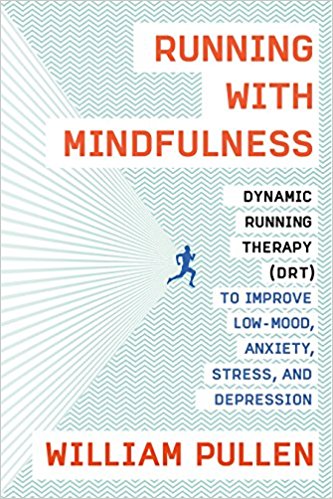Book review: Running with Mindfulness: Dynamic Running Therapy (DRT) to Improve Low-Mood, Anxiety, Stress, and Depression

By William Pullen. New York: Penguin Life, 2017. ISBN-10: 0735219796. Paperback, 224 pages.
For as long as I can remember, running has been a part of my life. I chose to review this book, Running with Mindfulness, thinking it would improve my running—in particular, getting into “the zone” and being surprised when reaching my destination without recollection of pain, exhaustion, or the environment. However, that would be mindless running. Mindful running is just the opposite and focuses on the immediate present. In order to review this book I solicited the opinions of a few of my colleagues who are more conversant with mindfulness therapy.
The author is a psychotherapist who, based on his own life struggles, developed a program to improve low-mood, anxiety, stress, and depression. It is aimed at anyone who is feeling stuck and is interested in exploring self-awareness through exercise, either alone or preferably with a partner.
The first part of the book includes a useful review and description of mindfulness. The start of one’s session (or run) begins with a four-stage grounding exercise. The reader is directed to focus on a question to explore during the physical activity: “moving with intention.” Finally, the reader is to make notes.
Although this book is labeled running with mindfulness, I think it might better be labeled exercising with mindfulness. The techniques in the book can readily be applied to any exercise that leads to the achievement of “flow,” a state of complete absorption in the activity.
The author encourages the reader to find a suitable partner willing to undertake the journey and to be a nonjudgmental listener. This would not work for everyone, but could be useful for some.
After the first three chapters on the basics, the book is divided into chapters on anxiety, depression, anger, relationships, and decision making. Each chapter has several questions to explore while exercising, along with space to record one’s thoughts and conclusions. The author encourages note-making as being therapeutic.
I particularly enjoyed the chapter on parents and kids. It gave me some conversation ideas to explore when running with my grandchildren.
I enjoyed this book, which reinforced what I already know about the benefits of running. It also gave me ideas to focus on during runs, rather than being mindless.
Given the beneficial effect of exercise on the mind, the incorporation of mindfulness therapy makes this an even better resource to recommend to patients who are struggling with anxiety, depression, and relationship issues, and it may eliminate the need for medication.
—WRV

